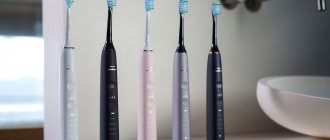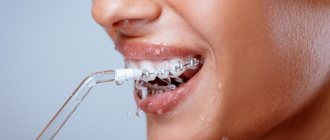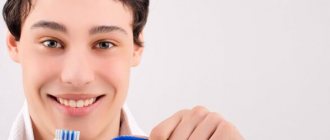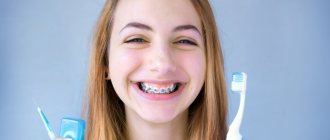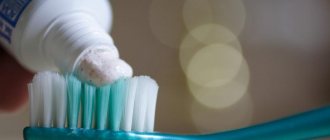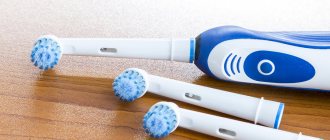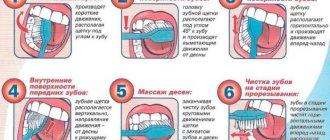Wearing braces requires careful regular care. Lack of proper hygiene can lead to the development of tooth decay, gingivitis and other dental problems. Many people are interested in the question: is it possible to clean braces with an electric brush? We'll tell you in the article.
In this article
- Do I need to brush my teeth with braces with a toothbrush?
- Can I use an electric toothbrush?
- What requirements must an electric brush for braces meet?
- Is it possible to clean braces and teeth with an ultrasonic brush?
- Is an electric brush enough?
- Conclusion
Do I need to brush my teeth with braces with a toothbrush?
The procedure for hygienic care of teeth with installed braces differs from traditional cleaning. A regular toothbrush is not enough to care for braces. In addition, you will need several special brushes, as well as superfloss, irrigator and rinses.
Whether you can clean your braces with a brush or not depends on what kind of brush you use. To care for orthodontic appliances and the oral cavity, you will need the following types of toothbrushes:
- Regular with soft bristles.
- Orthodontic with V-shaped cut in bristles.
- Interdental (so-called brush).
- Mono-tuft - a brush that has only one tuft of bristles.
The oral care procedure must be approached comprehensively and teeth should be brushed using all of the listed brushes.
Features of care when wearing braces
To clean braces, orthodontists had to develop a step-by-step care plan, including numerous accessories for comprehensive cleaning of the oral cavity: tooth enamel, interdental spaces, as well as the braces themselves outside and in accessible cavities.
Additionally, it was necessary to take into account the abundance of hard-to-reach areas and the intensity of plaque formation after eating. If you don’t understand how to brush your teeth with braces and follow your usual care regimen, the consequences can be serious:
- Destruction of the tooth crown and the onset of caries.
- Increased enamel sensitivity.
- Gum disease and frequent stomatitis.
- Termination of orthodontic treatment until the bite pathology is corrected.
- Bad breath.
The basis of the problems will be actively reproducing pathogenic microflora, which occurs due to pieces of food stuck in the structure and between the teeth. To remove the smallest microparticles of food and avoid the appearance of plaque, you must follow the rules for cleaning braces.
Can I use an electric toothbrush?
Some patients clean them with an electric toothbrush after getting braces. There is a myth that this should not be done, because electric brushes can damage structural parts, as a result of which it will have to be replaced.
Dentists refute this opinion and say that brushing your teeth with an electric brush is acceptable. The main thing is to choose the right model, which is equipped with orthodontic attachments, and follow the doctor’s recommendations.
The use of electric toothbrushes in caring for braces is even preferable for a number of reasons. Such brushes remove plaque better because they automatically perform tens of times more cleaning movements than we can do with our hands.
Modern sonic and ultrasonic models clean not only through mechanical action, but also using sound waves and pulsations. Using electric brushes, you can remove plaque and dirt from under the gums, from between teeth and other hard-to-reach areas.
General rules for caring for braces
If you want to maintain healthy teeth, you must follow the general rules for caring for braces. Let's describe them briefly:
- For braces, special toothbrushes are used that allow you to clean the enamel and all elements of the orthodontic structure.
- Treatment of the oral cavity should be performed 4-5 times a day or more often (after all meals, as well as in the morning and evening).
- It is necessary to clean not only the teeth themselves, but also all accessible surfaces of the braces.
- It is advisable to buy toothpaste with a high content of fluoride and calcium to increase the protective properties of the enamel. For the paste to be effective, it is recommended to regularly change it to a product from another company, since the enamel gets used to a certain composition and stops reacting to it.
- If you cannot clean some places, you should resort to the help of additional devices: dental floss, special brushes, etc.
- If you use rinse aid, do not use regular brands, but only ones that do not contain alcohol or dyes.
The main task of caring for the oral cavity while wearing braces is to preserve the enamel. This can be done in different ways. Read for interest what scientists are offering today: Scientists have found a way to protect tooth enamel in cancer patients.
What requirements must an electric brush for braces meet?
To ensure not only effective, but also gentle care of braces, the brush must meet a number of requirements.
- Synthetic bristles.
It cleans well, but bacteria do not multiply in it as actively as in natural ones.
- Small cleaning head.
It is advisable to choose models with a round head no larger than 1.3-1.6 cm. Such brushes will not damage fragile structural elements, and they better penetrate the distant teeth and other hard-to-reach places.
- Soft bristles.
This will avoid damage to the structure.
- Combination of technologies.
To care for braces, some dentists recommend choosing electric brushes that combine reciprocating and pulsating technologies. This provides better cleaning quality and allows you to remove the maximum amount of plaque in a shorter time.
- Special orthodontic attachments.
Be sure to choose an electric brush with special attachments. For example, any Oral-B electric toothbrush comes with a set of Braun Oral-B Ortho Care Essentials orthodontic attachments. It has different attachments that are suitable for high-quality cleaning of teeth around the locks and in the spaces between teeth.
When buying an electric brush to care for braces, it is important to consider that the attachments will wear out faster than with standard cleaning, so they will have to be replaced more often.
Comparison table of characteristics
For a quick analysis of the presented products, the main characteristics are collected in a table:
| The product's name | Nozzle shape | Compatible with electric toothbrushes |
| Sensi Ultrathin | Round petal-shaped | Oral-B Genius, Pro, Smart and Vitality |
| CrossAction | Round | Triumph, Smart, PRO, Vitality, Genius |
| 3D White | Round with rubberized bowl | All except Pulsonic |
| Precision Clea | Round in the center with a recess | All except Pulsonic |
| Sensitive | Round | All |
| TriZone | Elongated, oval | All except Pulsonic/Sonic |
| Stages Kids Cars | Round | Stages Power |
| Stages Kids Princess | Round with bristles of different lengths | Stages Power |
| Stages Kids Avengers | Round | Stages Power |
| Stages Kids Frozen | Round | Oral-B Stages Power |
When choosing a new head for your Oral-B electric toothbrush, you should consider the impact and desired effect, as well as the level of stiffness of the bristles. All attachments with reciprocating technology are suitable for any brushes of this brand (except for one series). And this top with pros and cons, customer reviews and recommendations from professionals will help you make the right choice.
Is it possible to clean braces and teeth with an ultrasonic brush?
Manufacturers of some ultrasonic brushes say that this is the optimal and gentle option for caring for braces. For example, the Emmi-Dent 6 Platinum Carbon ultrasonic electric brush, according to the manufacturer, provides gentle and high-quality care for any dental structures. Cleaning is carried out using ultrasound, which carefully removes plaque, prevents the formation of tartar, has an antimicrobial effect, and also has a beneficial effect on the gums and soft tissues. Due to ultrasonic cleaning, the electric brush does not have a strong mechanical effect on teeth and braces, does not injure the gums and does not damage the details of the orthodontic structure.
The Emmi-Dent ultrasonic brush operates on safe ultrasound with a frequency of 96 million pulsations per minute, it is made using patented technology, and its use is recommended by the Russian Dental Association. This brush comes with a special toothpaste without scratching abrasive particles. When the paste interacts with ultrasound, nano-sized bubbles are formed. They damage the shell of microbes and ensure cleaning of teeth in microcracks, near the clasps of the brace system, in periodontal pockets and other hard-to-reach areas.
Please note that not all dentists share the opinion of the manufacturers of ultrasonic brushes that they are ideal for caring for braces. Some doctors are of the opposite opinion and are convinced that ultrasound can harm the orthodontic structure. Therefore, it is important to discuss the choice of an electric brush for cleaning braces in advance with the doctor who will install the braces.
Bristles stiffness
The bristles are the most expensive part of a toothbrush and determine how thoroughly and effectively you clean. In the production of modern brushes, artificial bristles are used, which will not only last longer, but will also not become a habitat for bacteria and microorganisms.
According to the stiffness of the bristles, brushes are:
- soft and ultra-soft;
- medium hardness;
- tough.
Do not choose a hard brush yourself - it may not fit and damage the enamel and gums. These brushes are suitable for caring for some removable dentures.
Most people are comfortable with soft or ultra-soft
brushes
with a lot of bristles. If you like coffee and smoke, choose a brush with medium hardness. The main thing is to remember that it is easier to damage enamel than it seems.
Is an electric brush enough?
Even the most modern and high-quality toothbrush is not enough to fully care for the oral cavity of a person who wears braces. To maintain dental health, comprehensive hygiene is important, which, in addition to brushing with special toothbrushes, includes the use of superfloss, irrigator and mouth rinses:
- Superfloss is a dental floss specially designed for orthodontic patients. It is more convenient to insert it into the interdental spaces compared to regular floss, and it also allows you to efficiently clean the surface of the tooth around the lock.
- Every person who wears dental appliances needs an irrigator. This device improves the quality of oral hygiene several times and reduces the risk of caries and other diseases. The irrigator directs a powerful stream of water, which removes dirt and plaque from under the edge of the gum, from interdental spaces and other areas that could not be cleaned by other means.
- Rinse aid. This product not only washes away the remaining plaque and dirt, but also has an antiseptic and anti-inflammatory effect. You should choose a mouthwash as prescribed by your doctor.
Why additional equipment is needed
It is after the braces have been installed that areas appear on the teeth that are simply impossible to clean with an ordinary toothbrush, because it cannot even reach those places. If action is not taken in time, food that is retained will form harmful bacteria in the oral cavity. An ordinary brush can even cause harm, because both the tooth pulp and the gums are very vulnerable when wearing braces.
It must be remembered that hygiene is the most important thing in the prevention of many diseases that arise in the oral cavity. From this it turns out that it is necessary to carry out ideal teeth cleaning.
How to care for her?
In order for such an important device to serve you for many years, helping to clean the oral cavity efficiently and effectively, pay attention to the tips below:
- Nozzles are subject to periodic treatment with an antiseptic and replacement.
It is necessary to constantly rinse brushes/nozzles with running water before/after hygiene procedures. Leftover food left on the villi can cause the spread of bacteria and microorganisms. - The device should be stored in an upright position, the brushes should be stored in empty, dry glasses or stands.
- The nozzles are subject to periodic treatment with an antiseptic (once a week) and replacement (every three to four months).
- After hygiene procedures, check the charge level of the brush to avoid draining the battery.
Devices for cleaning bracket systems
Braces are available from different materials. These are metal, ceramics, medical sapphires. Each system has hard-to-reach places, as well as elements that require careful handling. Rough cleaning of the structure will damage the braces and even the enamel, so it is important to follow the advice of orthodontists and use the recommended devices. Among them:
- Ortho brush.
- Mono-beam (single-beam) brush.
- Interdental dental brush.
- Superfloss, floss, threads for cleaning teeth.
- Irrigator.
In addition to toothbrushes you will need:
- Toothpaste – regular or orthodontic.
- Foams for cleaning braces.
- Mouthwash – for gums and teeth.
- Solution for irrigator – with antibacterial effect.
Additionally, orthodontists include wax in the kit for patients. Its task is to protect the oral mucosa from injury by hard and protruding segments of the brace system.
V-shaped orthodontic brush
The ortho brush differs from the classic height of the bristles - elongated around the perimeter and short in the middle. This arrangement improves the quality of teeth cleaning. With horizontal movements of the orthobrush along the jaw line, the central rows of bristles clean the clasps and arch, and the bristles along the edges clean the interdental space and open areas of the teeth.
There are several things to consider when choosing an orthodontic brush. The product must have:
- soft pile;
- good thickness;
- head sizes up to 3 cm.
Compactness guarantees maneuverability and access to all teeth, and the soft bristles do not harm the enamel of the orthodontic structure.
Mono-beam brush
The single-tuft brush is designed for targeted cleaning of hard-to-reach areas. The product has a curved L-shaped handle and a small tuft of bristles at the end. The beam is made in such a way that when cleaning it completely covers the neck of the tooth.
Rodikova Tatyana
It is better to take mono-tuft brushes with soft bristles. And you don’t need to be afraid that they don’t clean well. At the appointment, I teach how to use this tool correctly, so the quality of care for my patients is always excellent.
Can I clean my braces with a regular or electric toothbrush?
A classic toothbrush is prohibited while wearing braces. You can clean it, but it will not do any good. Removal of dirt will be superficial, and hard-to-reach areas will remain uncleaned.
As for electric models, they can be used, but with reservations. Rotary and sonic electric brushes with soft bristles or orthodontic attachments are permitted. Ultrasonic options cannot be used, since the aggressive influence of ultrasound negatively affects the structure of the adhesive composition and can easily cause damage to the corrective structure.
You can return to using electric toothbrushes after removing your braces.
Orthodontic interdental brushes
Brushes are small brushes with short bristles. There are three product options in orthodontics:
- cylindrical - uniform height of bristles arranged in a spiral relative to the axis of the structure;
- cone-shaped - short villi at the top and elongated at the base of the brush;
- curved - the working part is located at an angle to the handle.
Angled and cone-shaped brushes clean best, but cylindrical ones are also allowed. The device perfectly removes plaque around the braces, under the arches and between the teeth.
The bristles of the brush and the areas between them quickly become dirty, so you should change the brushes every two weeks.
Dental floss for cleaning braces - floss or super-floss
For thorough cleaning of the brace system, doctors recommend superfloss. This dental floss has rigid ends, which makes it easier to pull under the archwire, and has a complex structure that guarantees high-quality cleaning. The second option is waxed floss for cleaning teeth, which glides and does not cling to braces. Otherwise, dental floss is selected as usual - according to manufacturer and thickness.
Plaksina Margarita
I recommend super floss to my patients. This is a fixed size thread with a hard tip. Moreover, it has variable thickness and areas with a spongy structure, which allows it to literally absorb plaque and clean tooth enamel well.
Oral irrigator
An irrigator is a device that cleans teeth with a narrow directed jet released under a certain pressure. When choosing a model, you should pay attention to:
- Type – compact with batteries and a compartment for water or bulky stationary with mains power.
- Pressure – permissible adjustment in the range of 0.7-4.8 bar.
- Modes – types and quantities.
- Variety of attachments.
- Compact size.
Irrigators perfectly clean interdental areas and hard-to-reach areas of orthodontic structures, but do not replace toothbrushes. This is a helper tool.
Toothpastes – orthodontic and plain
Orthodontists give the following recommendations regarding toothpastes:
- During the first weeks after installing braces, avoid products containing high amounts of calcium and fluoride.
- After the enamel gets used to the presence of the corrective structure, give preference to fluoride-containing pastes.
- Buy enzyme-containing formulations to quickly break down food debris and reduce the rate of appearance of pathogenic microflora during the day.
It is also allowed to use familiar toothpastes - the choice is up to the patient.
Foams and gels - quick cleaning of braces
Dental foams and gels can create additional antibacterial protection and quickly remove plaque from teeth. The products have a thick, dense consistency and are well applied to orthodontic structures. These are excellent preventative agents for preventing the formation of caries and tartar.
Foams and gels are a solution for quick hygiene. For use on the road, at work, at school, on a trip - when you don’t have a toothbrush with you.
Dolotova Marina
Many patients are surprised that there are such wonderful foams. They are really comfortable. The consistency is like a gel. They clean perfectly and have an excellent antibacterial effect. Especially indicated for children who cannot brush their teeth after school breakfasts and lunches.
Mouth rinses
Rinsing your mouth after eating and brushing your teeth is a necessity. Especially if it is not possible to carry out proper care and brush your teeth. Special means act comprehensively:
- freshen breath;
- destroy pathogenic microflora in the oral cavity;
- protect against caries;
- reduce the risk of inflammation.

